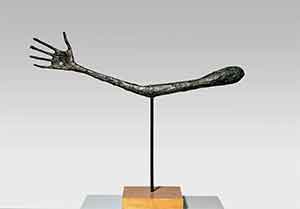The face of 900s : self and collapse of being; the physiognomy
by Francesco Carelli
Professor FM , Milan and Rome
At Palazzo Reale in Milan, this exhibition of works from the illustrious collections of the Centre Pompidou in Paris on the theme of the portrait and the self-portrait features eighty master-pieces by the leading artists of the 20th century, including Pablo Picasso, Henri Matisse, Amedeo Modigliani, Henri Laurens, Fernand Leger, Alberto Giacometti, Francis Bacon.
After the first modern revolution of the portraits of humanists by Durer and school, after the breach of Impressionism and its assertion of the painter’s independence, the modern artist’s engagement in portraiture involved going beyond the goal of capturing an expression to explore their subjects innermost self as well as their own artistic intentions. At the same time. artists feed themselves from the constraints previously inherent in the portrait, those imposed by their clients, who formerly expected not only a flattering portrayal but also an assertion of social status through a set of perfectly codified signs.
Between psychoanalytical theory, where the interpretation of dreams is seen as the path of knowledge of the subconscious, and other sciences or pseudo-sciences such as physiognomy, which sought objective information about personality in the shape or expression of the face, the turn of the century saw a convergence of efforts to penetrate what human beings regarded as the unknown and sometimes frightening part of themselves. Two artistic movements, namely Fauvism and Expressionism, echoed the subjectivity of the individual. The rings around the eyes of the women painted by Chabaud can be seen as metonyms of their dark side: femmes fatales or fallen angels pictorially set up as idols of a new urban and electrical world. The theme of melancholy in Modigliani and Derain, and the tension of the gaze exchanged between artist and model, as in Le Fauconnier and Marquet, heighten the almost magical presence of the subject’s inner world.
A new man ? A Nietzschean superman ? The isolation of the face from the rest of the body and the simplification of human morphology for a perfect form take sculpture away from the image of the subject’s outer envelope. This assertion of an anti-mimetic creed is connected in the case of Constantin Brancusi with a Platonic conception of sculpture as idea. Reference was often made by Cubists to ritual masks or archaic facial expressions borrowed from Primitivism, and their representations did not fail to arouse revulsion in the public, who saw them as an insult to the basis of humanity and even as blasphemous towards the part of man that God created in his own image. Resemblance, a concept inherently bound up with the portrait, appears to have to be definitively discarded. But if we are far away from the mimetic exercise of “ feature by feature “, the artist’s analysis and synthesis of the subject’s appearance make it possible to distinguish new canons of human beauty as well as and expressivity that sometimes betrays an element of personality.
The works gathered together here share a wild delight in imperfection, diametrically opposed to the canons of perfect beauty inherited from the classical art of ancient Greece. Both Francis Bacon and Alberto Giacometti produce figures constantly at the breaking point of deconstruction or decomposition. The “ collapse of the being “ as Jean Clair wrote, a breakdown of the innermost Self, a vision of death that introduces itself constantly, but in some cases more than others, in the art of portrait. In Giacometti’s striking portrait of Isaku Yanaihara, the miniaturization of the head, which seems to be set back from the plane of the body, captures all the power and authority of the subject. Giacometti’s universal human face is also an expression of the crazy struggle of life. Jean Dubuffet’s mass of lines, like a doodle drawn during a phone call, presents a swarming mass of beings stripped of their individuality.
Dominated by Minimalism, the 1960s are characterized by abandonment of the principle of subjectivity in art, whereas the mass media ( cinema, television, video and photography ) instead accentuated the principle – inherent in the portrait – of staging. The Self gave way to the icon and the image.
Kurt Kren reconsiders physiognomy and other sciences of the facial features through the test developed by the Hungarian psychopathologist Leopold Szondi, who established a set of 48 remarkable heads supposed to exemplify eight psychopathologies identified by him. Kren cinematically reproduces the selective, memory-appropriating work with respect to faces.



